Adapted Physical Education for those with special needs - PowerPoint PPT Presentation
1 / 11
Title:
Adapted Physical Education for those with special needs
Description:
In 1990, the Individuals with Disabilities Education Act (IDEA) was passed, ... http://www.palaestra.com/ Specific Adaptations and Teaching Strategies can be found at: ... – PowerPoint PPT presentation
Number of Views:2508
Avg rating:3.0/5.0
Title: Adapted Physical Education for those with special needs
1
Adapted Physical Educationfor those with special
needs
- By Reid Bennett
- October 2006
2
Introduction
- In 1990, the Individuals with Disabilities
Education Act (IDEA) was passed, requiring that
all people with disabilities, of school age, have
access to Physical Education in a normal school
environment. - It further required that each student with a
disability have an Individualized Education
Program (IEP) drawn up which would include a
program of adapted physical education appropriate
to the individual.
3
OverviewHow can we make adapted physical
education a reality?
- In this presentation physical educators will
learn how to - Educate ourselves
- Use our resources
- Meet the national standards
4
Summary SlidesWhen educating ourselves, some
good questions to ask might be
- What is adapted physical education?
- Adapted Physical Education is Physical Education
which has been adapted or modified, so that it is
as appropriate for the person with a disability
as it is for a person without a disability.
5
More questions
- What are the disabilities that my students have?
- The Individuals with Disabilities Education Act
(1990) uses the term disability as a diagnostic
category that qualifies students for special
services. These categories are - Autism
- Deaf Blindness
- Deafness
- Hearing impairment
- Mental retardation
- Multiple disabilities
- Orthopedic impairment
- Other health impairment
- Serious emotional disturbance
- Specific learning disability
- Speech or language impairment
- Traumatic brain injury
- Visual impairment including blindness
6
Use our resourcesPhysical educators are not
expected to have all the answers to every
disability!
- Ask the classroom teacher for ideas.
- Ask the guardian for special needs of the
student. - Ask the occupational and physical therapist for
suggestions. - Use the multitudes of adapted physical education
websites available for activity ideas. - Last, but not least, when possible ask the
student for suggestions.
7
Meet the National Standardsfor more information
go to http//www.cortland.edu/apens/
8
Although there are 15 components to the national
standards, its not as overwhelming as it may
seem. Several components can be intertwined with
each other. For example
9
Websites
- Adapted Physical Education National Standards can
be found at - http//www.cortland.edu/apens/
- Activities and Assessment Instructions can be
found at - http//www.pecentral.org/adapted/adaptedmenu.html
- The Council for Exceptional Children and
Information Center can be found at - http//ericec.org/faq/adapt-pe.html
- Forum of Sport, Physical Education, and
Recreation for those with Disabilities - http//www.palaestra.com/
- Specific Adaptations and Teaching Strategies can
be found at - http//www.asdk12.org/Depts/ape/adaptations/
10
Print Resources
- Cratty, Bryant J. (2004). Adapted Physical
Education Self-Control and Attention. Focus on
Exceptional Children, 37(3), 1-8. - Lytle, R.K. and Gayle E. Hutchinson. (2004).
Adapted Physical Educators The Multiple Roles of
Consultants. Adapted Physical Activity
Quarterly, 21, 34-49. - Place, K. and Samuel R. Hodge. (2001). Social
Inclusion of Students with Physical Disabilities
in General Physical Education A Behavioral
Analysis. Adapted Physical Activity Quarterly,
18, 389-404. - Articles 1 and 3 are useful for teachers in
understanding the behaviors of their students as
well as their behaviors toward their students. - Article 2 is useful for the physical educator as
well as everyone involved in the development of
the child to better understand the role of the
physical educator.
11
Conclusion
- If the physical educator educates
himself/herself on the meaning and needs of
adapted physical education, goes to the available
resources, and meets the national standards, all
children with disabilities can have physical
education appropriate for them.

